Amish Refrigerator Dill Pickles
Amish refrigerator pickles are a type of pickles that are made without traditional canning methods. They are called "refrigerator pickles" because they are prepared and stored in the refrigerator instead of using hot water or pressure canning.
The great thing about Amish refrigerator pickles is that they are quick and easy to make, requiring minimal equipment and time. Plus, they turn out crisp and flavorful since they are not exposed to high canning heat.
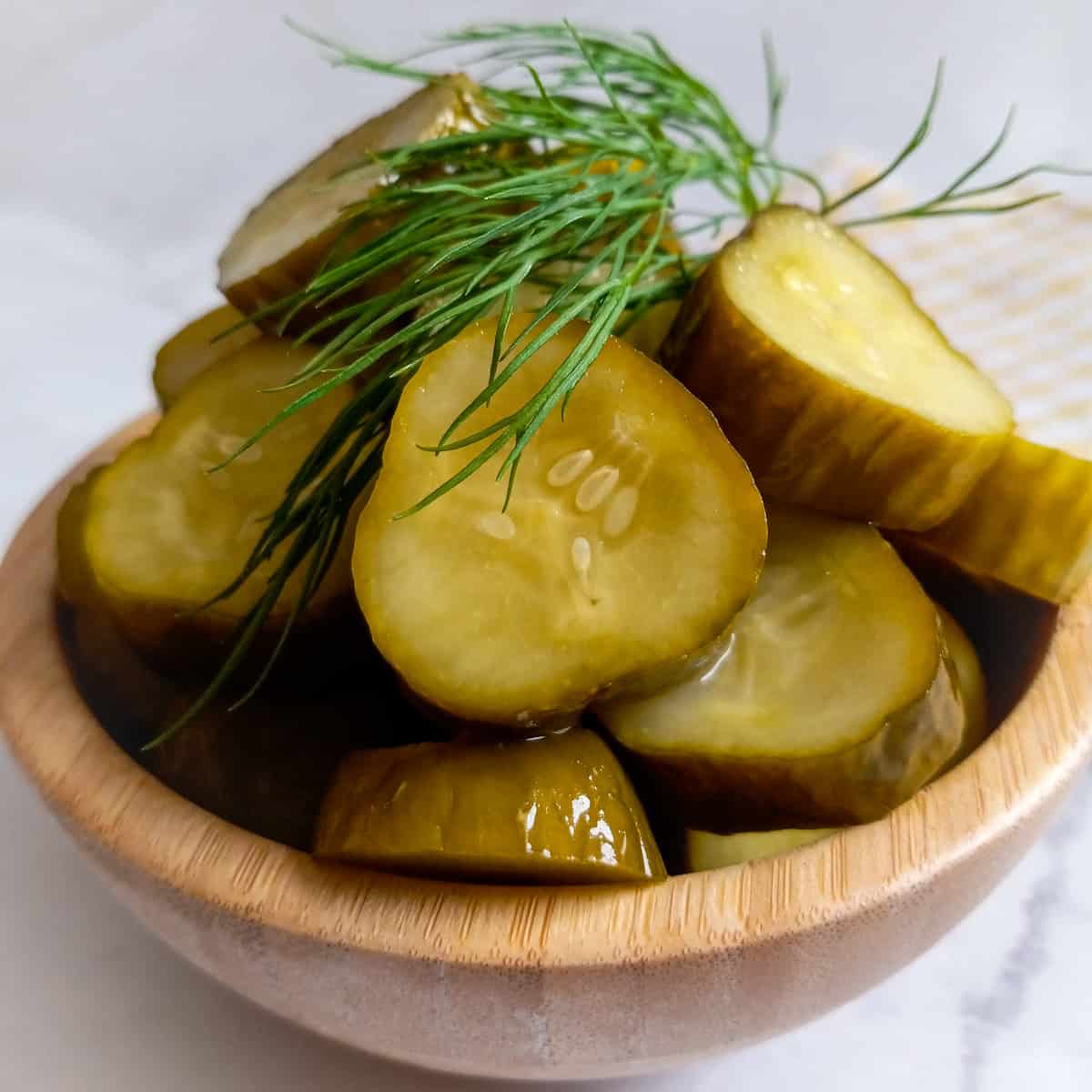
However, it's important to note, that Amish refrigerator pickles are not processed for long-term shelf life. Therefore, they should be stored in the refrigerator and enjoyed within a couple of months.
Easy 24-Hour Refrigerator Dill Pickles
Making refrigerator dill pickles is incredibly easy and quick. Unlike traditional canning methods, this process only takes a few minutes to make a gallon of pickles.
When growing cucumbers in the garden, they can quickly pile up on you and leave you wondering what to do with them. Fortunately, making refrigerator pickles is a great way to preserve them for several months.
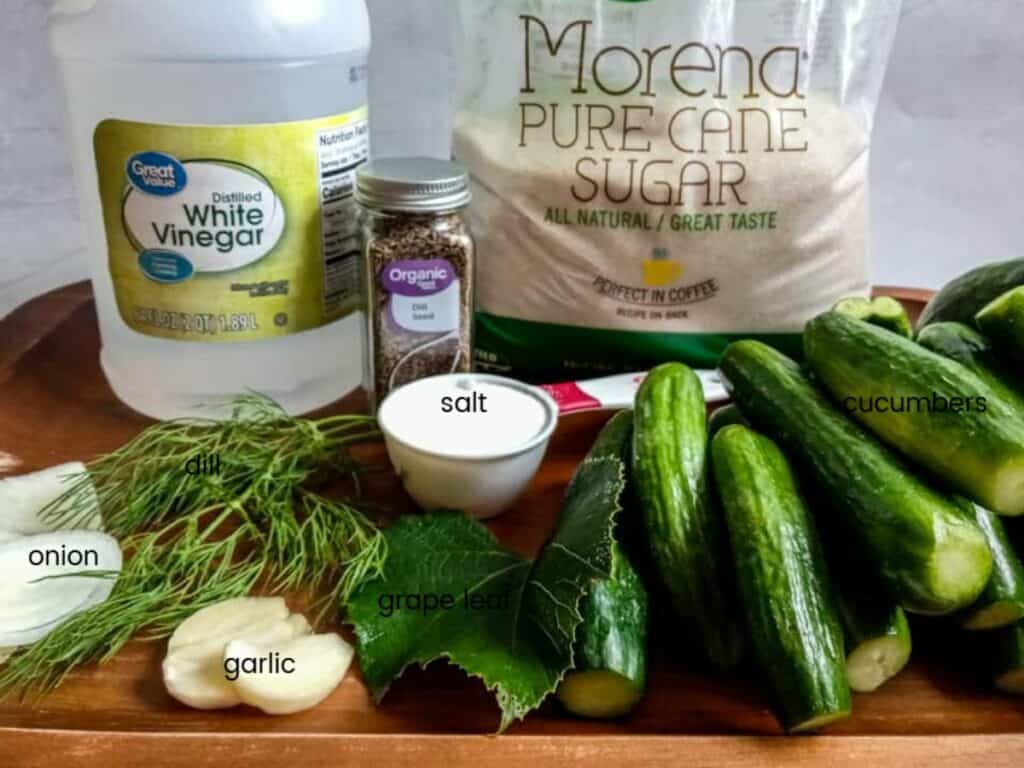
This post contains affiliate links...
How to Make Old-Fashioned Refrigerator Pickles
To make Amish refrigerator pickles, start by washing, removing the ends, and slicing or spearing the cucumbers. (I typically cut mine into approximately 1/4-inch rounds. But you could slice them thinner for sandwiches or whatever way you enjoy your pickles.)
Next, take a gallon jar and add a couple of slices of onion and garlic to the bottom, along with fresh dill and a grape leaf. Fill the jar with the sliced cucumbers. (If you don't have a large gallon jar, you can divide everything into four quart jars.)
Mix vinegar, water, sugar, and salt to prepare the brine solution. Bring it to a boil and carefully pour it over the cucumbers in the jar. Then add the remaining onion, garlic, dill, and grape leaf to the top. Seal the jar and refrigerate it, allowing the flavors to blend and the cucumbers to pickle.
You can start enjoying them after 24 hours. However, the flavors will be stronger if you let them soak for a few days.
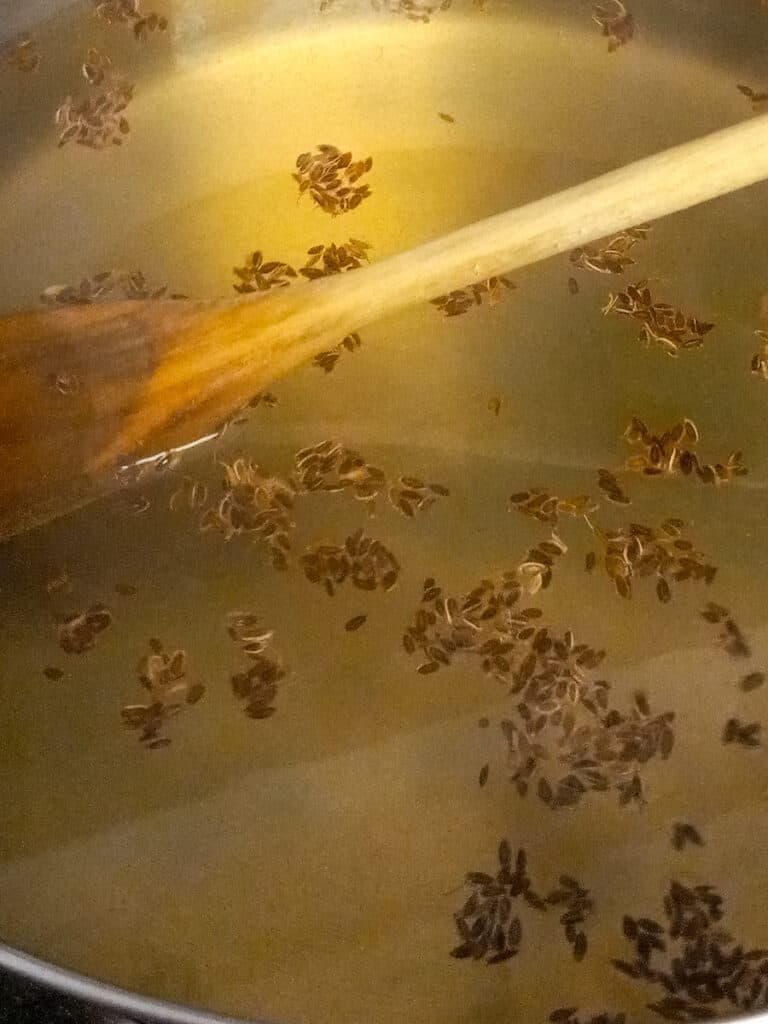
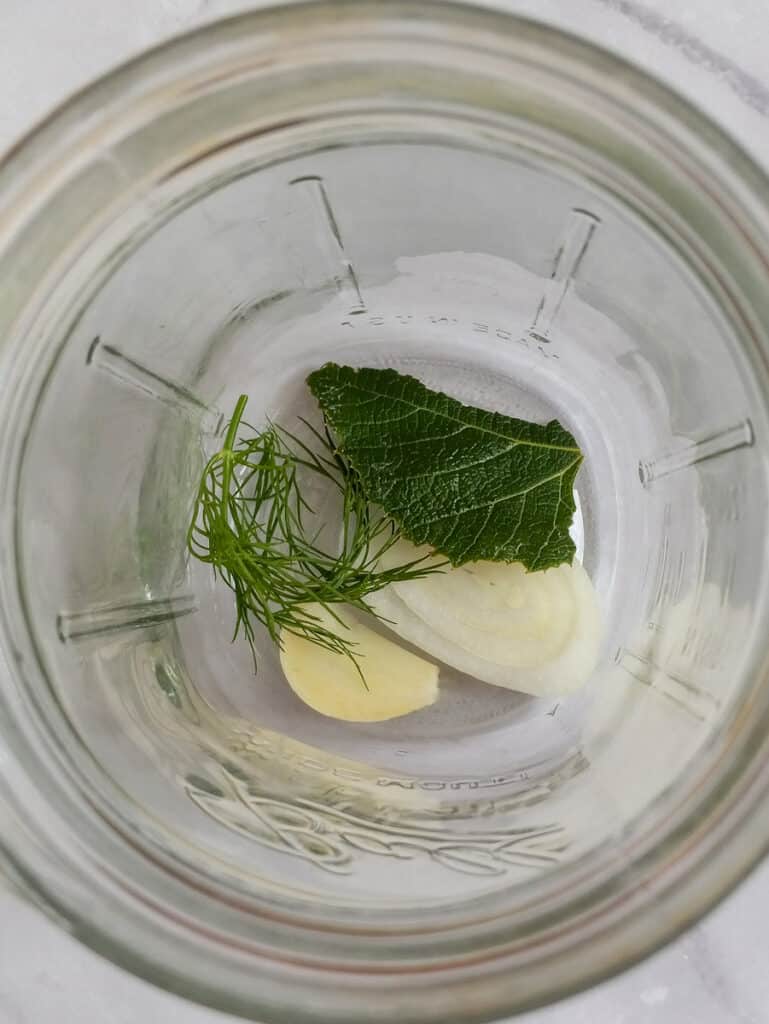
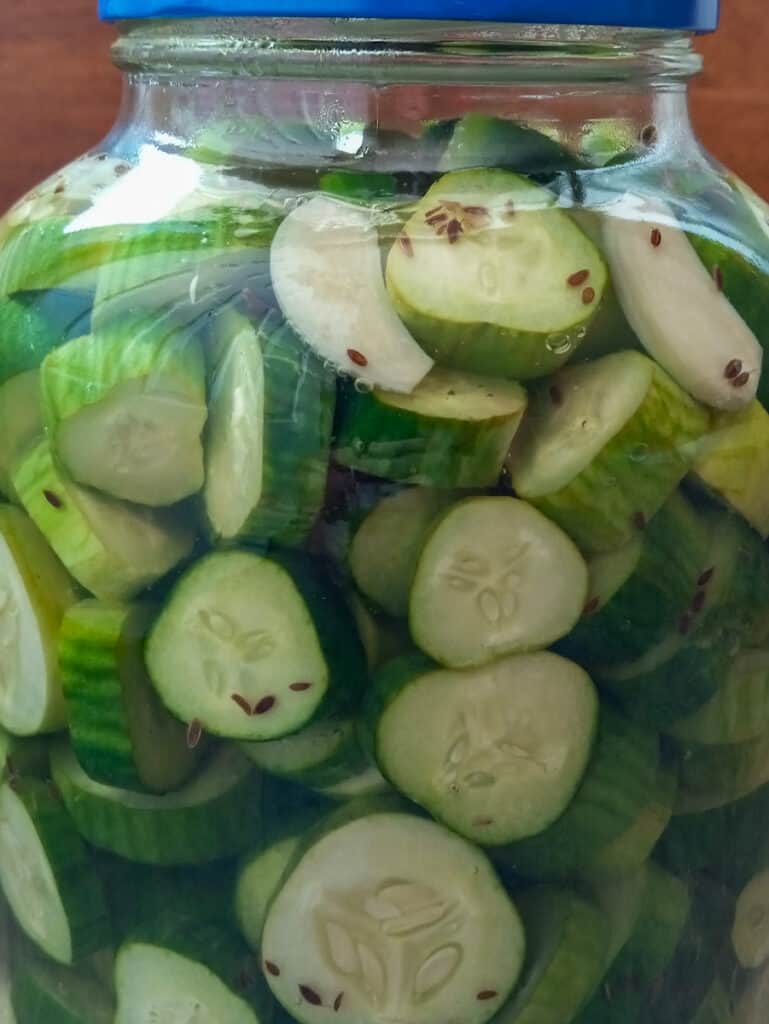
Ingredients
Each ingredient in refrigerator pickles serves a specific purpose:
- Vinegar: Vinegar gives pickles their tangy taste and acts as a natural preservative by creating an acidic environment that stops harmful bacteria from growing.
- Sugar: Sugar brings a hint of sweetness to balance the vinegar's tartness and enhance the pickle's overall flavor.
- Salt: Salt is essential for flavor and preservation. It draws out moisture from the vegetables, resulting in a crispy texture. Salt also hinders bacterial growth, aiding in the preservation process. (I use sea salt.)
- Garlic: Garlic adds a strong and distinctive flavor to pickles, providing depth and complexity to their taste.
- Onion: Onions add a mild and sweet flavor to the pickles.
- Dill: Dill is an herb with a fresh, grassy flavor. It imparts a signature taste to dill pickles and complements the other ingredients. Dill is particularly associated with dill pickles, hence the name.
- Grape Leaf: When added to refrigerator pickles, a grape leaf acts as a natural source of tannins. These tannins contain enzymes that prevent the vegetables from softening during the pickling process, keeping the pickles crunchy. The tannins from the grape leaf help preserve the texture, ensuring that the pickles remain firm and crisp. Some people also believe that grape leaves enhance the flavor of the pickles, adding a subtle earthy note to the overall taste.
These components work together to create a well-balanced and flavorful pickle, with each ingredient playing a role in enhancing the taste, texture, and preservation of the final product.
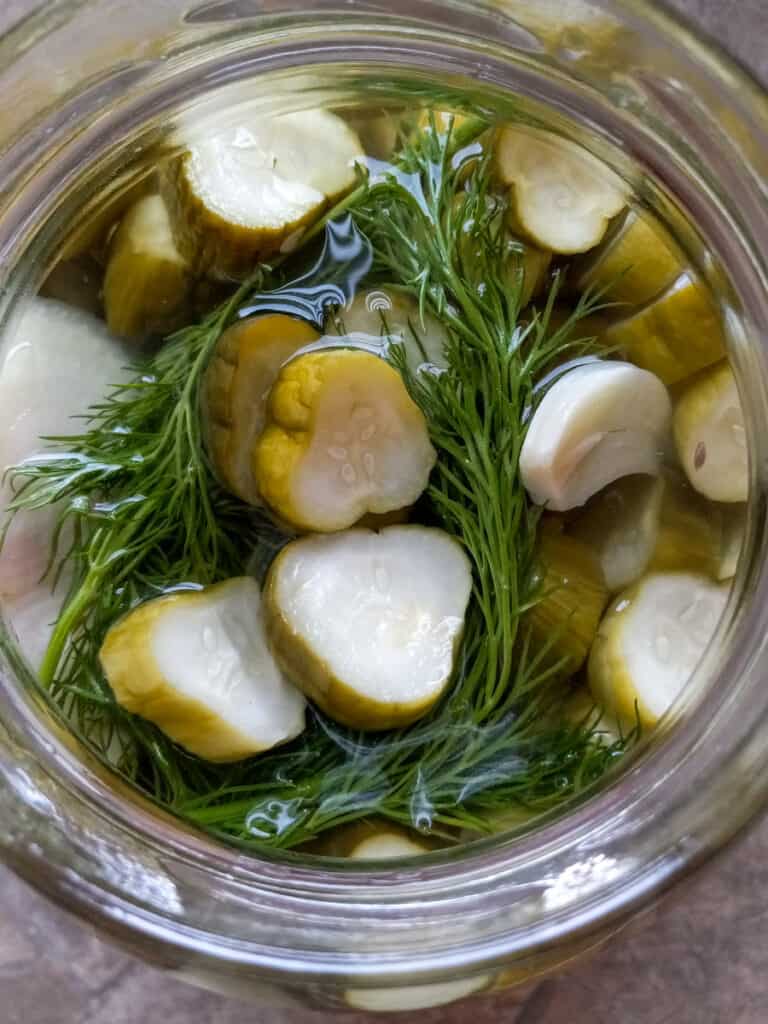
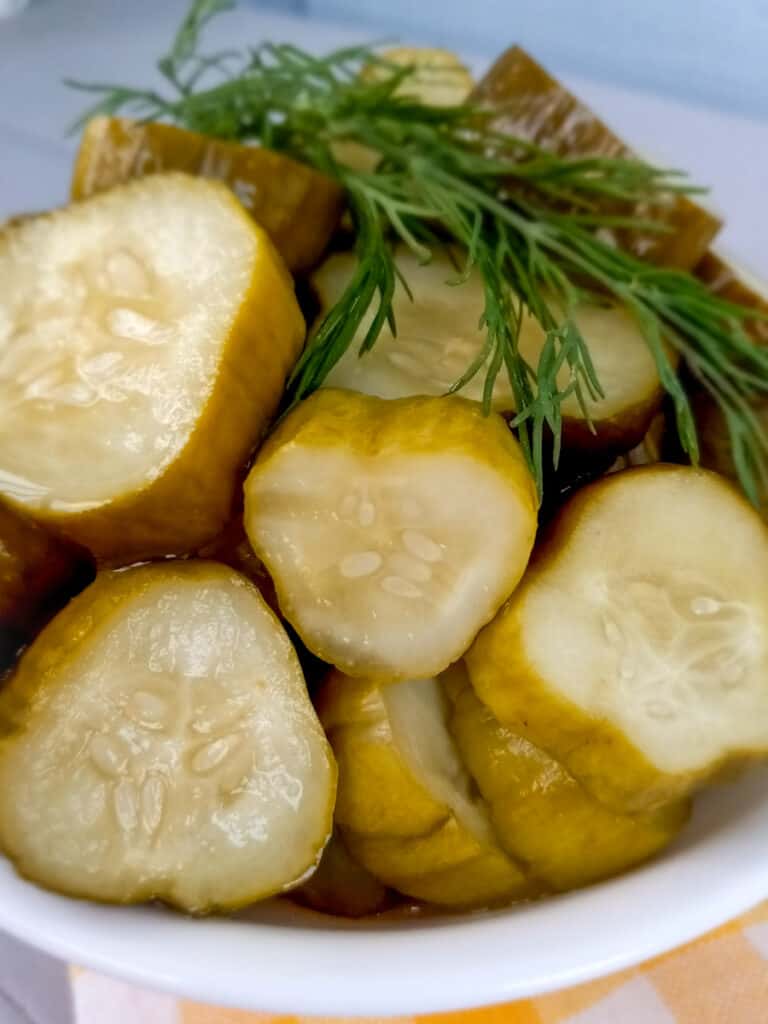
What Kind of Cucumbers Should I Use?
Cucumbers can vary significantly in taste. I remember one year when I planted some that turned out to be incredibly bitter, and I ended up throwing most of them away. Unfortunately, I cannot recall the specific variety.
However, for the last two years, I planted the "Beit Alpha" cucumber seeds from Bakers Creek Heirloom Seeds company. And I've been happy with them.
Small, crisp cucumbers are the best, and my kids love snacking on the baby ones. Larger cucumbers tend to have more seeds and lack the desired crispness. So I make it a daily habit to visit the garden and pick them, ensuring we don't end up with oversized, seed-filled cucumbers.
And if you are buying cucumbers, I recommend opting for pickling cucumbers or the English variety that comes individually wrapped in plastic.
How to Use Raw Pickles
Raw refrigerator pickles can be used just like any other pickles.
The way I typically slice them, they are a bit too thick to add to a sandwich. But no worries. Simply slice them in half to make them thinner.
I love adding dill pickles to potato salad, chicken salad, etc. These raw pickles can bring a delightful flavor and satisfying crunch to a variety of dishes. Enjoy experimenting with them in your recipes!
They make a tasty addition to sandwiches, salads, and burgers, or can be enjoyed as a tangy snack on their own.
Customize
Refrigerator pickles are versatile and can be customized according to personal taste preferences. You can experiment with different vegetables, spices, and brine flavors to create unique combinations.
I love sweet dill pickles with just a touch of heat. Several years ago, my mom-in-law had a pickle business that specialized in sweet hot flavors. She took regular whole dill pickles, sliced them, and added garlic, sugar, and Tabasco sauce. And believe me, they were the best pickles ever!!
So feel free to add some heat by including sliced jalapeños, red pepper flakes, or Tabasco sauce to the brine. To combat some of the heat, you could also add more sugar.
Crisp Homemade Pickles
When canning pickles, it can be a little tricky to make a pickle that stays crisp. And it doesn't matter how great the flavors are, if you have a mushy pickle, you lost me. Because in my opinion, a pickle isn't worth eating if it's not crispy.
This Amish refrigerator pickle recipe is a sure way to create delicious, crispy pickles. I hope you enjoy them. If you try this dill pickle recipe, I would love to hear from you in the comments below.
And if you have lots of fresh cucumbers, perhaps you'd like to try my cucumber salad recipe.
If you enjoy pickled foods, you might also like Amish chow chow and pickled red beet eggs.
Amish Refrigerator Pickles Recipe
Ingredients
- 1 gallon cucumbers, sliced into coins or spears
- 1 small onion, sliced
- 1 - 2 garlic cloves, sliced
- fresh dill
- 1 - 2 small-sized grape leaves, optional
Brine:
- 4 c. water
- 2 c. white vinegar
- 1 3/4 c. sugar
- 1/4 c. salt
- 1 tsp. dill seed, optional
Instructions
- Wash, remove the ends, and cut the cucumbers into approx. 1/4 inch thick slices or cut them into spears.1 gallon cucumbers, sliced into coins or spears
- Add half of the onion slices, one sliced garlic clove, a couple of sprigs of fresh dill, and a grape leaf to the bottom of a large gallon jar.1 small onion, sliced, 1 - 2 garlic cloves, sliced, fresh dill, 1 - 2 small-sized grape leaves, optional
- Fill the jar with sliced or speared cucumbers, leaving enough room at the top to add the remaining garlic, onion, dill, and grape leaf.
- In a large cooking pot, mix the water, vinegar, sugar, salt, and dill seed. Bring it to a boil, then pour over the top of the cucumbers. Wipe the top and seal with the lid. Cool. Store in the refrigerator for up to a couple of months. They are ready to start eating after 24 hours.4 c. water, 2 c. white vinegar, 1 3/4 c. sugar, 1/4 c. salt, 1 tsp. dill seed, optional

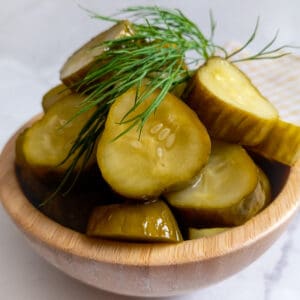


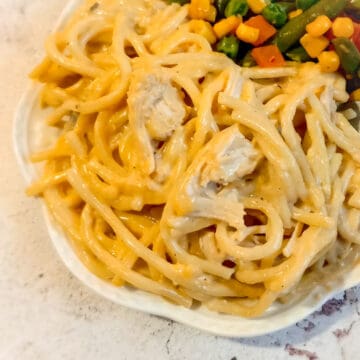

Jeannie
Where do you find the grape leaves? What kind of grape leaves do you use? Thanks so much!
Anna
I have my own Concord grape vine. You can buy some on Amazon, but actually, since the pickles don't get cooked, it's probably fine without the leaves too.
Kathy Roberts
Can you freeze them.
Anna
I have never frozen pickles. I feel like it would affect the texture of the pickles. They keep for a long time in the refrigerator, or you can water bath them to seal the jars to make them shelf stable.
Tina
Hi there I have made these and they are the best pickles I ever had thank you. However I hate waste. Can I just throw more cucumber into the brine in the jar when the pickles are all eaten?
Anna
I have done that before. However, the pickles didn't have the same depth of flavor as the first ones.